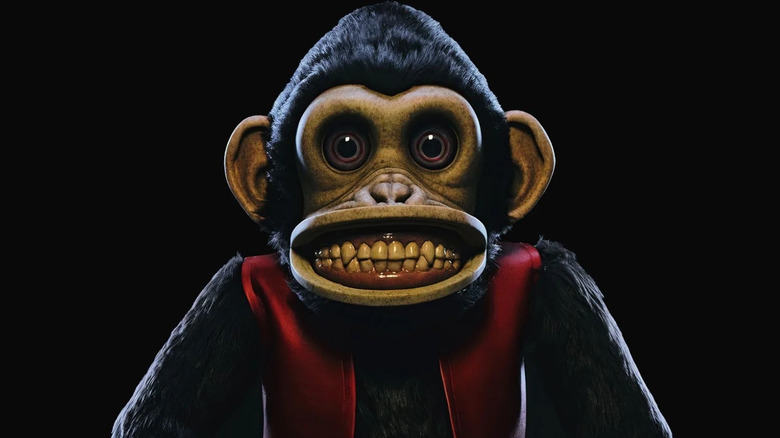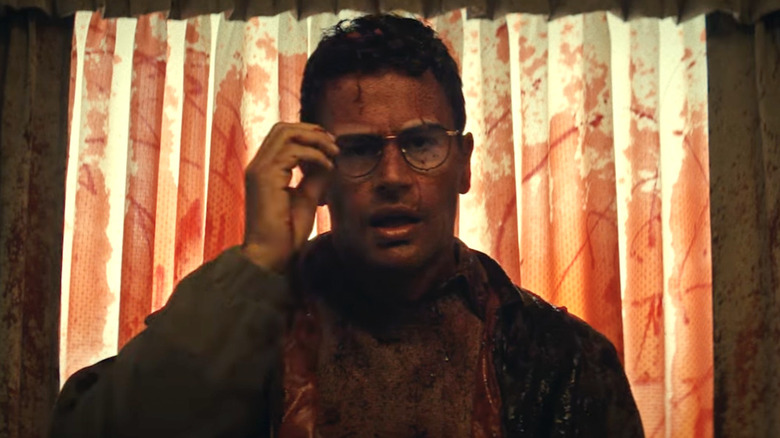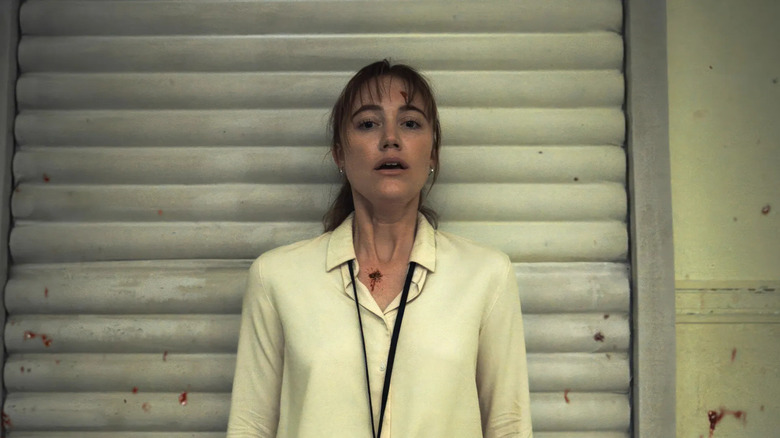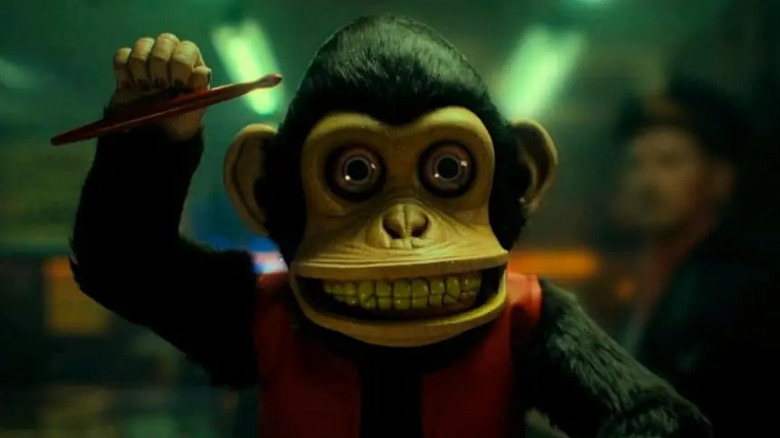How The Monkey Differs From Longlegs — And Every Other Oz Perkins Horror Movie
This article contains spoilers for "The Monkey."
Although it's still possible to get into the weeds when discussing auteur theory, it's generally become accepted that directors, especially if they're also acting as their own screenwriters, have a large degree of creative control over their films. As such, it's possible to find common threads that connect a certain filmmaker's work, whether those threads are thematic, stylistic, or some combination of the two. For example, think of the Stanley "Kubrick stare," the Spike Lee floating dolly shot, Alfred Hitchcock and voyeurism, Steven Spielberg and father figures, and so on. Some directors may seem easier to clock than others, of course, especially if they exclusively or generally work within a particular genre. Yet even those who remain in one genre can contain as much artistic diversity as those who attack a wide range of subject matter.
Take, for instance, Osgood Perkins. As a filmmaker, Perkins is still at the beginning of his directing career, though he's been in showbiz practically since his birth, given that he's the son of actor Anthony Perkins and actress/model Berry Berenson. Born in 1974, Perkins was inducted into film and television early on, portraying a young version of his father's most iconic character, Norman Bates, in "Psycho II," and has continued to appear in films as an actor from 1993 to the present day. His latest on-screen appearance happens to be his latest film, "The Monkey." It is, to date, the only movie he's directed in which he plays a small part: a character named Chip, who briefly becomes the guardian of the twins Hal and Bill Shelburn (Christian Convery) before he, too, suffers a brutal and untimely death at the behest of a cursed toy monkey the boys have inherited.
Perkins' appearance in "The Monkey" is just one of many elements that make the film stand apart from his biggest hit, "Longlegs," as well as the rest of the director's horror features. Although there are a couple of moments here and there that recall Perkins' previously established style and themes that tie "The Monkey" to the rest of his work, the film is notably a swerve in a new direction for the director. Though the reason for this can be chalked up to a "confluence of things," as Perkins himself told me in a recent interview, it can also be attributed to the fact that "The Monkey" may be Perkins' most personal film yet.
'The Monkey' swaps dread for dark humor
The foremost difference between "The Monkey" and Perkins' prior films is the fact that the majority of "The Monkey" isn't intended to scare an audience, but rather make them laugh at the pitch-black humor of the story. It's a fully fledged horror-comedy, and although it's certainly not a feel-good one, its rhythms and tone are in the service of building up and paying off a series of gags. These gags very much include kills, the one aspect of the movie that is already its most discussed, given how elaborate, grotesque, outrageous, and just plain improbable these deaths are.
It's Perkins picking up the baton from Glen Morgan and James Wong, the filmmakers behind "Final Destination," "Final Destination 3," and "Black X-Mas," who themselves built upon gore pioneers like Herschell Gordon Lewis and film series like the "Friday the 13th" franchise in the way they presented kill sequences that were both very involved and incredibly gruesome. Perkins continues their traditions of baiting a gore-hungry audience in "The Monkey," showing us the various pieces of impending doom (an air conditioner on the fritz, a broken booby trap full of sharp objects, etc.) that the unsuspecting victims don't see until it's too late. These moments are anticipatory; no matter how ugly the end result may be, Perkins knows that we want to see how all the various pieces come together to bring about mayhem.
This technique is almost in complete opposition to the typical tone that Perkins establishes in his prior films. "Longlegs," as well as "The Blackcoat's Daughter," "I Am the Pretty Thing That Lives in the House," and even "Gretel & Hansel" evoke a particular sense of creeping dread that Perkins specializes in, a mood that suffuses every frame of each film so much that it establishes a high level of tension that Perkins never allows to be fully released. For some, this dread-filled tone combined with Perkins' usual somnambulant pacing — a quality which makes everything feel like you're stuck in a dream, or a nightmare — grates too much and ends up being dull. For others, like myself, this approach burrows under the skin and stays there. Except for perhaps a handful of brief moments (literally a couple of shots), "The Monkey" never approaches this pace or tone. It's almost as if the film were one big break with that tension Perkins had established for the first part of his career, making "The Monkey" the movie where he finally cuts loose.
In 'The Monkey,' Evil is random and impartial, not directed
Perkins' films have never been shy about featuring characters who suffer horrific (and, quite often, undeserving) fates, but there's one major difference between the poor unfortunate souls in the rest of his work versus those in "The Monkey." Namely, the victims of the monkey in "The Monkey" are completely chosen at random. In fact, it's a major plot point that Hal and Bill (played as adults by Theo James) cannot direct the monkey's powers toward anyone in particular, no matter how hard or how many times they try. Despite the fact that the monkey seems to prefer to kill people in increasingly elaborate, ridiculous, and over-the-top ways, it does not have any sort of secret, arcane master plan. Its victims truly are random, and the lack of reasoning is the entire point: the cursed object exists only to kill, which is what one could say is the intention of life itself.
That concept is Perkins' way of throwing up a big middle finger at the various atrocities that life makes all of us endure, and he's doing it with a wink and a laugh rather than a cry of despair. That's partially because the rest of his films are absolutely soaked in despair, or at least a sense of inescapable fate. "I Am the Pretty Thing..." is about three women whose destinies all involve each other and the house that they collectively meet their end within, a ghost story where the characters are all doomed from the start. It explores a theme that Perkins explores again and again, the idea of free will (insofar as it relates to escaping a dark fate) being either cruelly taken away or never actually being an option for his characters.
"The Blackcoat's Daughter," "Gretel & Hansel," and especially "Longlegs" all utilize occult explanations to evoke this theme. Each film involves a character who is a fully-fledged Satan (or demon) worshipper, who then commits acts of violence in their service. With the twisty narrative of "The Blackcoat's Daughter," the naiveté of the young "Gretel & Hansel," and the confusion and subterfuge perpetuated by Longlegs (Nicolas Cage), Perkins creates a world where the forces of Evil are omnipresent and intentionally directed at certain people. Ironically, this makes "The Monkey" his kindest film so far.
'The Monkey' may be Perkins' attempt to reconcile his own personal tragedies
A big reason why Oz Perkins fits all the prerequisites of auteur theory is that he's not making movies merely for love of the medium, and certainly not to just sell a product or work for a paycheck. Each one of his films is a personal one, too, as he uses the horror genre to explore themes and concepts that, in a non-genre setting, might be too raw and upsetting for most audiences to take. "The Blackcoat's Daughter" is, ultimately, a film about loss, something Perkins has unfortunately suffered through when it comes to both his parents. "I Am the Pretty Thing..." is a movie Perkins made about his attempts to connect with his late father, as he revealed on an episode of the "Post Mortem with Mick Garris" podcast. "Gretel & Hansel" — the only film Perkins has made that he hasn't written the screenplay for — concerns a pair of children left to their own devices who are abandoned by their parents. "Longlegs" goes even further than that, telling a tale of a woman who is flat-out betrayed by her parents, where the sins of her mother are visited upon her tenfold.
Clearly, Perkins has a lot of unresolved feelings about parenthood, the pressures put on children, and parents who either avoid their responsibilities or have them somehow subverted. A large portion of this theme must stem from Perkins' personal life and relationship to his late parents, along with the bizarre nature of how both passed away: Anthony Perkins from an HIV/AIDS contraction that he kept secret, and Berry Berenson from being a passenger on one of the planes that hit the World Trade Center on September 11th, 2001. Perkins has made no attempt to deny these connections, and once you're aware of them, you can see their influence on all of his films, but especially "The Monkey." In this film alone, there's a boy obsessed with the legacy of his late father, another boy trying desperately to connect with his distant father, the twin boys made despondent by the untimely loss of their beloved mother, and, by the end, a preponderance of planes full of passengers falling out of the sky (an element which, as of this writing, has way too much resonance for all of us, not just the director).
If there's a silver lining to all of this, it's that Perkins' use of his work as a form of therapy may indeed be working. There's no way of knowing that for sure, of course, and far be it for me to imply any parasocial understanding of the man's private life. Yet it's curious that "The Monkey" is such a tonal swerve for the filmmaker, along with the fact that it's the first movie he's cast himself in as an actor, and his character is the only father figure in the film that we see suffer a gruesome demise. It feels like Perkins is enough of an artist as well as a human being to realize that he can't escape pointing a finger at himself, which is typically a good indicator of someone who's well-adjusted. Now that Perkins is laughing as well as crying, Melpomene and Thalia-wise, it's exciting to anticipate what new aspects of these themes, horror, and cinema he's going to explore next.



